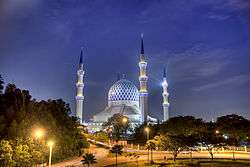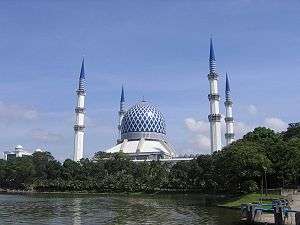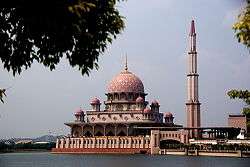Sultan Salahuddin Abdul Aziz Mosque
| Sultan Salahuddin Abdul Aziz Mosque | |
|---|---|
|
Masjid Sultan Salahuddin Abdul Aziz مسجد سلطان صلاح الدين عبدالعزيز | |
|
Sultan Salahuddin Abdul Aziz Mosque from Taman Tasik Shah Alam. | |
| Basic information | |
| Location |
|
| Geographic coordinates | 3°04′41″N 101°31′16″E / 3.078°N 101.521°ECoordinates: 3°04′41″N 101°31′16″E / 3.078°N 101.521°E |
| Affiliation | Islam |
| Branch/tradition | Sunni |
| Architectural description | |
| Architect(s) | Dato Baharuddin Abu Kassim |
| Architectural type | Mosque |
| Architectural style | Islamic, |
| Completed | 1988 |
| Specifications | |
| Capacity | 24,000[1] |
| Dome height (outer) | 106.7 m (350 ft) |
| Dome dia. (outer) | 51.2 m (168 ft) |
| Minaret(s) | 4 |
| Minaret height | 142.3 m (467 ft) |
| Materials | concrete, steel, aluminium, vitreous enamel coated steel panelling, timber, glass, ceramic tile |
The Sultan Salahuddin Abdul Aziz Shah Mosque (Malay: Masjid Sultan Salahuddin Abdul Aziz) is the state mosque of Selangor, Malaysia. It is located in Shah Alam. It is the country's largest mosque and also the second largest mosque in Southeast Asia after Istiqlal Mosque, Jakarta in Indonesia. Its most distinguishing feature is its large blue and silver dome. The mosque has four minarets, one erected at each of the corners.[2]
History
The mosque was commissioned by the late Sultan Salahuddin Abdul Aziz, when he declared Shah Alam as the new capital of Selangor on 14 February 1974. Construction began in 1982 and finished on 11 March 1988. The Mosque is also known as the Blue Mosque owing to its blue dome. The building has the distinction of having the largest religious dome in the world, it measures 51.2 m (167 ft) in diameter and reaches 106.7 m (350 ft) above ground level.[2] The four minarets, each reaching 142.3 m (460 ft) above ground level[3] are the 2nd tallest in the world, the distinction of the world's highest being held by the Hassan II Mosque (Arabic: مسجد الحسن الثاني) in Casablanca, Morocco.[4] In its early years, the mosque was listed in the Guinness World Records as having the tallest minaret in the world before being supplanted by the 210 m (689 ft) at the Hassan II Mosque[5] when that structure was inaugurated in August 1993. The Blue Mosque (Masjid Sultan Salahuddin Abdul Aziz) does however still maintain the distinction of having the world's tallest group of minarets as the set of four each stand at 142.3 m (460 ft) above ground level.
Architecture and features
The architectural design of Sultan Salahuddin Abdul Aziz Shah Mosque is a combination of Malay and Modernist style.

The mosque has the capacity to accommodate 24,000 worshippers at any one time[2] and is large enough that on a clear day it can be seen from some vantage points in Kuala Lumpur.[6]
The main dome of the mosque measures 51.2 m (167 ft) in diameter and 106.7 m (350 ft) in height from the ground level. It is constructed primarily from aluminium. The minarets are placed at each of the four corners and are 142.3 m (460 ft) tall.[7]
Elements of Malay and Islamic architecture are incorporated into the finishes of the building. Fine decorative khat (Arabic calligraphy) can be seen on the inner curve of the dome and parts of the walls. The calligraphy work was executed by the Egyptian calligrapher Shiekh Abdel Moneim Mohamed Ali El Sharkawi. Aluminium grills of intricate design can be found on the doorways, windows and walls of the Mosque. The windows are fitted with blue stained glass to reduce the amount of light that can enter the hall. The resulting filtered illumination renders a bluish ambiance to the interior spaces evoking a sense of peace and serenity. The high ceiling has triangular panels of red balau and ramin timber wood that are set in crisscrossing pattern. The dome is constructed of aluminium and the outer surface is clad with vitreous enamel-baked triangular steel panels decorated with a rosette of verses from the Qur'an. The main prayer hall is over two levels, is fully carpeted and air conditioned and is one of the largest such spaces in the world. The upper gallery of the prayer hall is reserved for the use of female worshippers. The second floor houses a gallery, the ground floor contains the administrative office, conference rooms, library, reception and lecture rooms.[2]
The Blue Mosque overlooks the Garden of Islamic Arts, a landscaped park inspired by the Quranic Garden of Paradise (Jannah) (Arabic: جنّة). This 14 hectares of spiritual sanctuary houses nine galleries exhibiting a rich array of Islamic arts such as calligraphy, sculptures, paintings and architecture. The site is occasionally used for traditional Islamic performances.[8]
See also
| Wikimedia Commons has media related to Sultan Salahuddin Abdul Aziz Mosque. |
References
- ↑ "Blue Mosque (Sultan Salahuddin Abdul Aziz Shah Mosque)". Malaysian Ministry of Tourism-VirtualMalaysia.com. 2011. Retrieved 26 January 2011.
- 1 2 3 4 "Blue Mosque (Sultan Salahuddin Abdul Aziz Shah Mosque)". Malaysian Ministry of Tourism-VirtualMalaysia.com. 2011. Retrieved 26 January 2011.
- ↑ "Tourism Malaysia-Selangor destinations-Blue Mosque". Government website-Tourism Malaysia. 2011. Retrieved 26 January 2011.
- ↑ Kingfisher Geography encyclopedia. ISBN 1-85613-582-9. Page 137
- ↑ "Travel Experience-The Blue Mosque". Ministry of Tourism-VirtualMalaysia.com. 24 December 2004. Retrieved 26 January 2011.
- ↑ "A Focal point for Shah Alam Muslims". New Straits Times. 11 March 1988. Retrieved 17 November 2010.
- ↑ "Tourism Malaysia-Selangor destinations-Blue Mosque". Government website-Tourism Malaysia. 2011. Retrieved 26 January 2011.
- ↑ "Tourism Malaysia-Selangor destinations-Blue Mosque". Malaysian Government-Tourism Malaysia. 2011. Retrieved 26 January 2011.

.jpg)


